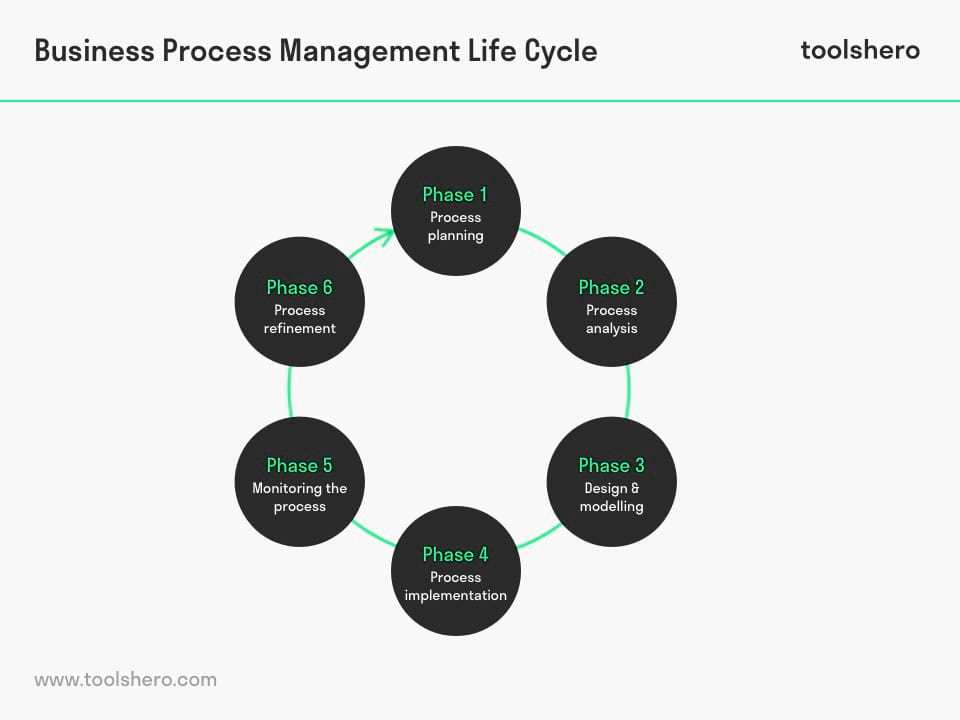Business Process Management (BPM)

Business Process Management (BPM): this article provides a practical explanation of Business Process Management (BPM). Next to what this concept (including definition) is, this article also highlights how does it work in practice, the Business Process Management Life Cycle, the BPM Core Points and the benefits why to apply in an organisation. After reading, you’ll understand the basics of this process management concept. Enjoy Reading!
What is Business Process Management (BPM)?
The definition of Business Process Management
The definition of Business Process Management is that it is the design, implementation, use, and adaptation of business processes for the purposes of optimisation and standardisation.
The term Business Process Management includes how organisations analyse, identify, change, and check various processes to make their business into a well-oiled machine. It’s an important part of running a business because a lacking or poor process limits the organisation’s capacity.
A good way to think about Business Process Management is as a business practice with techniques and structured methods. It’s not necessary a technology, although technologies that support this way of process optimisation are available. These technologies identify inefficient processes and change them to suit the future status quo better.
Business Process Management isn’t a one-off; it’s a continuous activity that involves several other forms of process management. BPM, for instance, uses Lean, Six Sigma, Business Process Mapping, and Business Process Re-engineering.
How does Business Process Management (BPM) work?
Business Process Management allows a to company take a step back and look at each business process individually. It analyses the current state of the processes and identifies areas of improvement in order to achieve a more efficient and effective organisation. That organisation works towards objectives, such as supplying products or services to consumers or transforming raw materials into parts which are then assembled into an end product by another organisation at another location.
Realising these goals requires carrying out specific tasks and activities. These day-to-day activities are called business processes. Basically that means that the day-to-day activities of businesses and organisations consist of business processes.
One example of a business process is the production process. Within said production process, however, there are additional processes that together make up production. Business Process Management (BPM) is about the management of all these processes, both large and small.
Some business processes are simple and consist of just two or three steps. Other business processes are much more complex, consisting of many steps and involving many people and variables. Because these processes are repeated regularly, it’s up to the organisation to think of new ways to optimise and standardise them. That’s where Business Process Management (BPM) is a useful tool.
There’s more than one way to do Business Process Management (BPM). It’s more of catch-all phrase, and it means that individual processes are continuously analysed and improved.
Business Process Management (BPM) does generally follow a cycle. Opinions and ideas about each phase depend on who you’re asking, but in general the following cycle represents common practice.
Business Process Management Life Cycle
The Business Process Management Life Cycle consists of the following phases:

Figure 1 – the Business Process Management Life Cycle
Phase 1: Process Planning, the start of Business Process Management basics
Everything starts with making a plan. This plan should serve as a guideline that must be followed by everyone carrying it out.
BPM starts with the development of a plan that clearly defines the strategy and the aims of the BPM initiatives. The strategy should be process-driven, and the plan should be designed in such a way that value to the consumer is assured.
Process planning and strategy consist of the following:
- Insight into the organisation’s goals and strategy (guide for BPM)
- Identification and listing of current processes with a thorough analysis of process architecture
Phase 2: Process Analysis
Just making a list of business processes isn’t enough. There’s a need for insight into the current processes, as these are the focus of any BPM initiative. Nobody is able to manage something they don’t understand. That’s why the purpose of this phase is to find out if the current business processes are aligned and in accordance with the business objectives.
The first step is often gathering information and data on the business processes. These are obtained from company records, strategic plans, process models, and employee experiences.
The analysis provides insights into the strengths and weaknesses of each individual business process and offers the ability to understand how these affect the organisation’s general performance. Both qualitative and quantitative analyses are used frequently.
Qualitative analyses are used to expose inefficiencies and to analyse and resolve relevant issues. Well-known tools that could help with this are:
- Value-added analysis
- Cause-effect analysis
- Pareto analysis
Quantitative analyses are about relationships between numbers, figures, models, and statistics. Tools and methods that can be used for this are:
- Process simulations
- Flow analyses
Phase 3: Design & Modelling
Depending on the results of the various analyses, it might be necessary to adapt or redesign existing processes. This step from the Business Process Management (BPM) life cycle is about coming up with a new process design. The most important activity in this phase is to determine whether the process is fine the way it is, or if it should be redesigned to create a better business process.
Business Process Mapping (BPM) creates a blueprint of the process, but it often also includes descriptions, diagrams, and illustrations. The most important thing is that the method offer end-to-end perspective for all processes within the organisation, whether they’re primary, supporting, or management processes.
If it’s decided that a process needs to be changed or redesigned, there are various options available to the user. First there’s continuous process improvement.
This approach involves looking for solutions to a problem within a process step by step. Business Process Reengineering (BPR) is another option.
This approach involves looking at the entire process structure and fully redesigning it. The goal of BPR is to better streamline processes or to make processes more effective and efficient.
Phase 4: Process Implementation
When the design and model are ready, it’s time to implement the changed process structure. Systemic implementation involves the use of software and technologies. Non-systemic implementation means these technological tools aren’t used.
The choice between the two will depend on the nature of the process and, to a lesser extent, the organisation’s resources. The use of supporting technology will cost the organisation money, after all.
Phase 5: Monitoring the process
When the new or revised process has been implemented, it needs be monitored, measured, and checked. This has to be done continuously.
The goal of monitoring the process is to obtain the information needed to determine if changes or adjustments should be made to the process design. Monitoring the process also yields data on the process’s performance.
These can be used to check if the adjustments have actually led to achieving organisational objectives. The analysis of business processes is the primary source of input for this phase. Monitoring business processes is often done using dashboards.
Phase 6: Process Refinement
Business Process Management (BPM) enables organisations to achieve and maintain high-quality business process. By monitoring and checking performance, they’re also able to continue to innovate and improve. This is primarily achieved through redesigns and BPR.
This phase aims for the improvement or refinement of three aspects:
- Process performance
- Process management
- The organisation as a whole
The Core Points of Business Process Management
Different studies show that there are at least five core points of Business Process Management.
Aligning strategy
The business processes should all be optimised in line with the general company objectives.
Leadership & ownership
From the first phase of the BPM life cycle, ownership and roles for different levels should be clearly defined. That same document should also offer clear guidelines on the decision-making process, as well as penalties and rewards. It’s important that these be carefully communicated to all members of the organisation. This ensures transparency and accountability.
Methods and tools
BPM activities often involve the use of methods or tools and technologies that simplify and support BPM. The most commonly used tool is Six Sigma, developed by Bill Smith.
IT
Over the years, BPM has become more associated with information technology. That’s because modern process management is conducted mostly with sophisticated IT solutions. IT therefore plays an important role in conducting and planning BPM activities.
Organisational Culture
Business Process Management (BPM) is not an independent unit within the organisation. BPM has to be implemented for all fields and within all domains. That’s why it’s important that the collective values in the organisation match the desire to carry out BPM activities. Whether BPM initiatives succeed or fail partly depends on the organisational culture.
Why Apply Business Process Management (BPM)? The benefits
The fact that nearly all organisations actively employ Business Process Management says a lot. They do this for the following effects, among others:
Revenue growth
BPM helps to align business processes and various functions to the customer’s needs. That automatically means improved customer satisfaction, reputation, and finally higher revenue and profits.
Cost reduction
Inefficiencies and waste of scarce resources are obvious reasons for unnecessary costs in organisations. Effective BPM offers a way to check the distribution of resources and allows management to implement any changes that might be needed to address inefficiencies.
Fewer mistakes
BPM standardises the business system with functions and responsibilities for each department. That means that each function and the tasks of each employee are defined in detail. This minimises risks due to human error in carrying out those functions. It also minimises the risk of fraud and negligence.
Increased productivity
Productivity is influenced by a variety of factors. These also include the correct use of resources and capital, human resources, and physical working conditions. BMP offers a set of best practices, allowing for the improvement of general productivity and efficiency.
Business Process Management (BPM) Summary
Business Process Management (BPM) is about optimising and standardising business processes to better serve the customer and to work more efficiently and effectively. All day-to-day activities in an organisation are business processes. It’s up to the organisation to decide how these processes are carried out. Managing, adjusting, and planning new business processes is part of Business Process Management (BPM).
Although there isn’t a single step-by-step plan for BPM, since every situation and process is different, a six-step general life cycle for BMP has been developed. First, it’s important that the business processes and organisational objectives be aligned.
Everything that is done using processes must be directly related to achieving these objectives. After that, the business processes are captured, for instance using Business Process Mapping (BPM), and then they’re analysed. The analysis shows whether or not a business process can be optimised.
After the improvements have been made to the process design, they’re implemented. After implementation the process is monitored for a long time to check whether the revisions have actually led to achieving organisational objectives.
Now It’s Your Turn
What do you think? Do you recognise the explanation of Business Process Management (BPM)? Are business processes carefully recorded and optimised where you work, too? Do you recognise certain techniques and methods from tools such as Business Process Reengineering? Do you have any tips or additional comments?
Share your experience and knowledge in the comments box below.
More information
- van der Aalst, W. M. (2004). Business process management: a personal view. Business Process Management Journal.
- Ko, R. K., Lee, S. S., & Lee, E. W. (2009). Business process management (BPM) standards: a survey. Business Process Management Journal.
- Rosemann, M., de Bruin, T., & Power, B. (2007). BPM maturity. In Business process management (pp. 322-338). Routledge.
- Snabe, J. H., Rosenberg, A., Mller, C., & Scavillo, M. (2008). Business process management: The sap roadmap. Sap Press.
How to cite this article:
Janse, B. (2020). Business Process Management (BPM). Retrieved [insert date] from Toolshero: https://www.toolshero.com/quality-management/business-process-management/
Original publication date: 06/02/2020 | Last update: 01/07/2024
Add a link to this page on your website:
<a href=”https://www.toolshero.com/quality-management/business-process-management/”>Toolshero: Business Process Management (BPM)</a>












